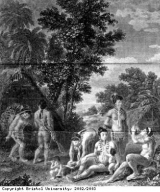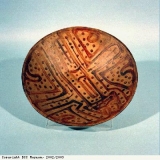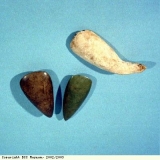Before the Europeans came
The history of the Caribbean did not begin in 1492 when Christopher Columbus landed in the Bahamas. The islands were already inhabited by the Ciboney, Arawak and Carib peoples from mainland America.
The Ciboney were a food-gathering and hunting people who may have migrated from Florida in southern North America. They moved in to the islands of Cuba and Hispaniola (now Haiti and the Dominican Republic) at least 5,000 years ago. The Ciboney were more or less killed off by other Amerindian (American Indian) peoples, as they are called, who moved into the islands.
The Arawak probably came from northern South America, about 5,000 years ago. They settled on a number of the Caribbean islands, where they lived by farming. They are often known as the Taino and the Igneri.
Later migrants, the Carib people, moved into the Caribbean islands and in some places pushed out the Arawak people. The Arawak were displaced in eastern Hispaniola, Puerto Rico, and almost all of the eastern Caribbean islands. This displacement happened within 100 years of the Spanish arriving in 1492. In the eastern Caribbean islands at least, it is likely that the Carib killed the Arawak men and married the Arawak women. The Spanish noticed on one island at least that the men and women spoke different languages.
The Spanish, the first Europeans to claim land on the Caribbean islands, were often harsh taskmasters. The Spanish cleric Bartolomé de Las Casas was appalled by the treatment of the island peoples. In 1560 he published a book, History of the Indies, to show how they had been killed and abused. Describing an attack on a village on the island of Trinidad, he wrote “I think 185 Indians were taken [as slaves] to the ship that day. Those who had managed to escape joined others in a village house … [the Spanish leader] Bono … set the straw on fire and burned them all alive”.
Colonisation by the European powers destroyed the existing island cultures. The Arawak people were friendly towards the newcomers. In return, they were made to work in the fields and mines, often being worked to death, and killed by European diseases like measles and ‘flu. The island peoples had had no contact with Europeans before 1492, and had never encountered smallpox, measles, ‘flu and similar diseases. Because of this, they had no immunity to them. When European sailors brought measles or ‘flu to the islands, the effects were devastating and many local people died.
The Caribs resisted European settlement on their lands and were therefore seen by Europeans as aggressive and dangerous. Many of the Carib died fighting the invaders.





